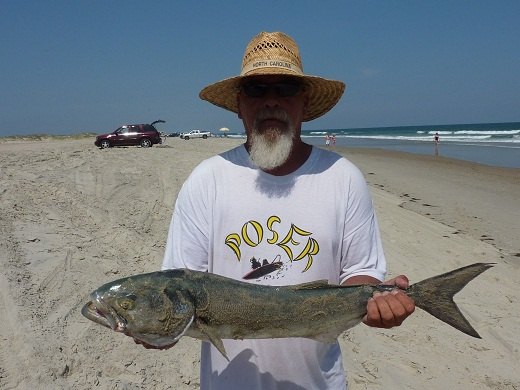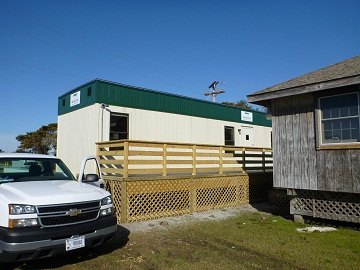In the Land of the Fee

A new trailer is in place behind the National Park Service Visitor Center on Ocracoke. A seven minute educational video has been made and screened. Two full time and two seasonal jobs have been created and are in the process of being filled. A new ramp and parking areas will open in the future. Who is paying for all this? Anyone who wants to take a vehicle into an off road area of Cape Hatteras National Seashore.
The fees are set at $120 per calendar year (ending December 31) and $50 for a 7 day period. The fees are similar to surrounding parks and ORV plans on Assateague and Cape Cod.

Supervisory District Ranger Kenny Ballance said beach driving on Ocracoke will now cost money, but won't be much different. No ramps are closing. The same beaches will be open in the off season. Seasonal closures due to bird and turtle nests will continue. "It's just another sticker you are paying for," said Kenny.
One of three sites where the stickers are available is on Ocracoke. The office will be open year round, 7 days a week from 8 a.m. to 4:30 p.m. It can accomodate 20 people at a time.
Will there be an option to get the permits on line? "Not this year." They become available February 15. A 30 day grace period follows with rangers issuing warnings rather than citations. But don't let them catch you out there without a permit after you've been warned, said Kenny. The penalties for beach driving without a permit are $150 plus $25 in court costs.
Visitors contacting realty and motel offices seem most concerned about the beach being open, said Kenny. There are five open ramps on Ocracoke, and there will be "just as much beach to drive on as before," he said. It might not be in the areas people are used to, "but it will be just as accessible for enjoyment."
The video people are required to watch is short and informative. "Anyone who watches it should go to the beach and not cause us to write them a ticket," said Kenny.
Neither Ranger Ed Fuller nor Kenny are concerned they will have to enforce the part of the rule declaring that the capacity of ORV areas is one vehicle per every 20 feet of space. They have never seen that many cars on the beach at once, said Ed.

The rule specifies equipment ORVs must carry, including a tire pressure gauge, jack, jack board, and shovel. These were included because "not everybody who comes to Cape Hatteras National Seashore uses common sense," said Kenny, "and you can quote me on that!" The law says beach drivers should lower their tire pressure "to maintain adequate traction." Who knew?
In the past the speed limit on the beach was 25 mph. It is now 15 mph, and 5 mph when passing pedestrians. "Pedestrians have the right of way on the beach. Period," said Kenny. "We hope that people have the courtesy to reduce speed, especially when passing parked cars. Our main concern is children running out," he said. The law says vehicles must pass on the landward side.
Kenny doesn't anticipate extra pressures on the pedestrian beaches past the campground and pony pens, but thinks the area between the lifeguard beach and campground may see increased use.
No permit is required to drive down roads to the sound, said Kenny. Local fisherman are grandfathered in on beach driving permits if they earn part of their living by fishing from the beach. NPS will contact commercial fishermen and provide them with free permits.
Kenny said the current administration won't enforce the arcane parts of the rule. People with questions can contact the Ocracoke District office at (252) 928-5111.
The full document is here. Scroll all the way to the very bottom of the page and begin where it says "Authority."



